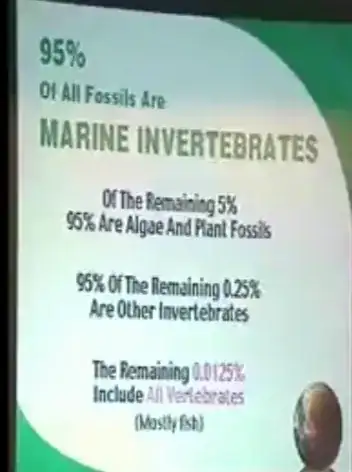
I found this claim in this Creationist YouTube video.
95% of all fossils are marine invertebrates.
Of the remaining 5%, 95% are algae and plant fossils.
95% of the remaining 0.25% are other invertebrates.
The remaining 0.0125% include all vertebrates (mostly fish).
(punctuation and capitalization mine)
Some more occurrences/variations of the claim:
At least 95 percent of all animal fossils are of marine invertebrates.
http://www.icr.org/article/real-nature-fossil-record/
In the real world, about 95 percent of all fossils are marine invertebrates, mostly shellfish (i.e., clams). Of the remaining 5 percent, 95 percent are algae and plant fossils (0.05 x 0.95, or 4.75 percent of the total) and 5 percent (0.05 x 0.05, or 0.25 percent of the total) are insects and other non-marine invertebrates and vertebrates. Of the remaining 0.25 percent of the total, 95 percent are insects and other non-marine invertebrates and only 5 percent (0.05 x 0.0025, or 0.0125 percent of the total) are vertebrate fossils (mostly fish; and finally, amphibians, reptiles, birds, and mammals).
http://www.creationsciencetoday.com/24-Standard_Geologic_Column.html
This last quote has a source
Morris, J.D. (2003). Is the Big Bang Biblical? Green Forest, AR: Master Books, 108–109; and Morris, J.D. (1994). The Young Earth. Green Forest, AR: Master Books, 70. Statistics provided by paleontologist Kurt P. Wise, Ph.D. Geology (Paleontology).
I found this claim in "The Young Earth" and partially in "Is the Big Bang Biblical" both (on Google books) without any references, so it seems to dead end with Morris. (Kurt Wise is apparently a prominent Young-Earth Creationist.)
The order of frequencies seems plausible to me (if leaving out trace fossils) but the break down of 5% of 5% of 5% feels a bit contrived. So, what's the relative representations of these families in the fossil record?